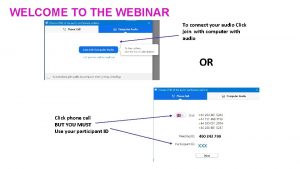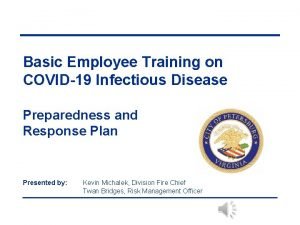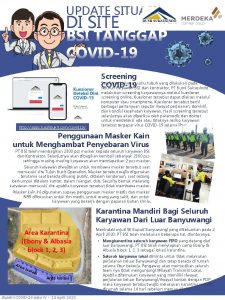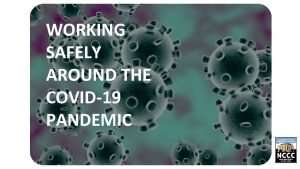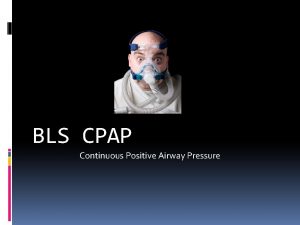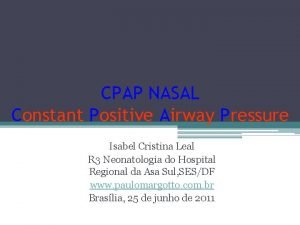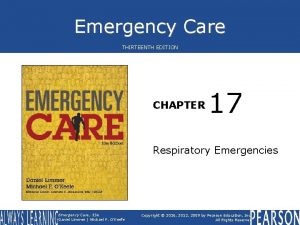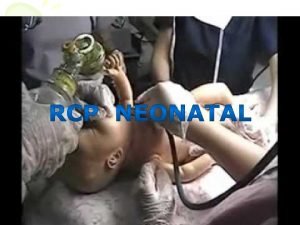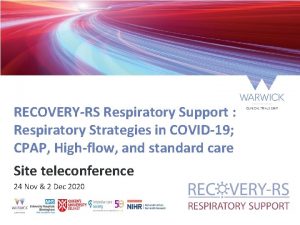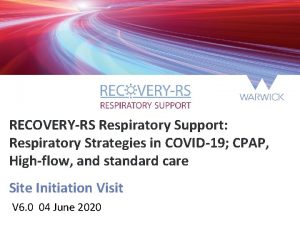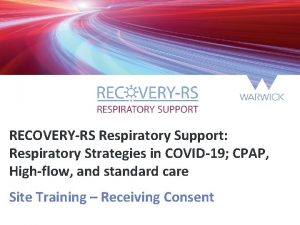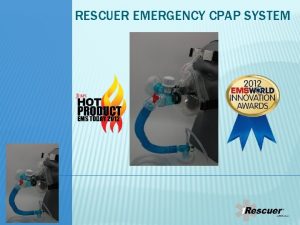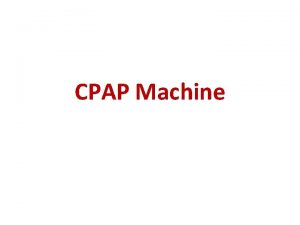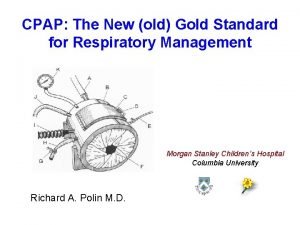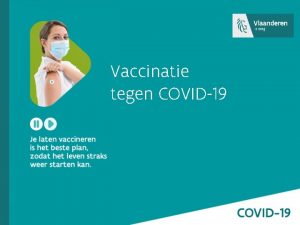RECOVERYRS Respiratory Support Respiratory Strategies in COVID19 CPAP











- Slides: 11

RECOVERY-RS Respiratory Support: Respiratory Strategies in COVID-19; CPAP, High-flow, and standard care Site Training – How to randomise

Acknowledgements

Eligibility Inclusion criteria ü Adults ≥ 18 years ü Admitted to hospital with suspected or proven COVID -19 ü Fi. O 2 >0. 4 and Sp. O 2 <94%* ü Plan for escalation to intubation if needed *Requirement for oxygenation should be ongoing (not transient) Exclusion criteria Planned intubation and mechanical ventilation imminent within 1 hour Known or clinically apparent pregnancy Any absolute contraindication to CPAP or HFNO Decision not to intubate due to ceiling of treatment or withdrawal of treatment anticipated Equipment for both CPAP and HFNO not available

Screening Site research team attend/contact hospital clinical areas Treating known or suspected COVID-19 patients Liaise with clinical staff to identify patients Acute Hypoxaemic Respiratory Failure Doctor/nurse/research team can assess and confirm eligibility prior to randomisation – complete eligibility form Justification for patient meeting all eligibility criteria Clearly documented in the patient’s medical notes

Randomisation Check availability of CPAP and/or HFNO device prior to randomisation (any brand of device can be used) None Devices available? Only one (CPAP or HFNO) Do not randomise Option 1 Randomisation CPAP vs standard care Option 2 Randomisation HFNO vs standard care Both CPAP & HFNO available Option 3 Randomisation CPAP vs HFNO vs standard care

Safety Alert: High-Flow Oxygen Dr Ganesh Suntharalingam - President, Intensive Care Society Urgently ensure liaison between clinicians and hospital oxygen engineering teams to ascertain: • the maximum flow rate from your VIE • any additional limitations to oxygen delivery owing to pipework architecture • calculate the maximum number of patients who can be treated with high flow devices such as wall CPAP and communication of this to the relevant clinical teams • undertake a daily count of the number of high-flow systems where the potential oxygen flow rate exceeds 10 L/min (this will include most wall CPAP systems, High Flow Nasal Oxygen (HFNO), some non-invasive ventilators used in acute settings, and many ventilators used in critical care units or operating theatres) • implement safety measures to prevent accidental O 2 system failure (such as limiting the number of these devices available for clinical use) “low oxygen pressure alarms” = indication of approaching flow limitation TAKE URGENT ACTION: Review usage, reduce demand, escalate for engineering assistance

Randomisation • Patients will be randomised to a 1: 1: 1 ratio • Interactive Voice Response (IVR) system (24/7 service) Call 02476 109940 • PIN access to be provided by email following ‘green light’ to begin recruitment – generic username for each site Complete Randomisation form Paper Randomise Database Using IVR PID to be entered directly into database* • Completed paper form to be filed in ISF *PID is redacted on entry

Co-enrolment will be reviewed on a case-by-case basis in accordance with NIHR-supported co -enrolment guidelines We will maintain a list of trials we are co-enrolling with on the trial website

Training requirements QA • Training is available on the trial website • As a minimum the PI of the site must complete and sign off all training modules on the website • PI to ensure that staff (e. g. doctor, nurse, research practitioner) have the appropriate knowledge and understanding of trial • All training should be recorded on the Confirmation of Online Training Form • Optional GCP training available on website • There is no need for the PI to provide a CV and GCP certificate.

Study oversight Investigator Site File (ISF) Available on website Close Out • • Monitoring Central monitoring approach will be developed that will take into account the challenging circumstances and staff pressures Resolve any outstanding queries Collect any outstanding data Ongoing responsibilities Site to archive trial documentation and data (at least 10 years)

Aide memoirs – available on website
